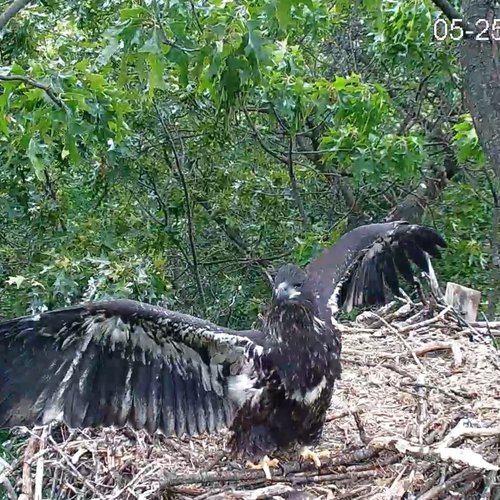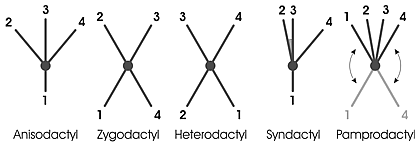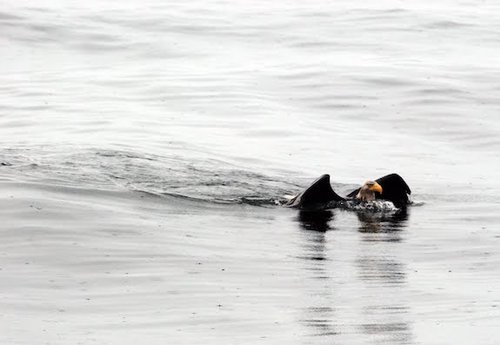Hanover Bald Eagle Blog # 21 - 2021
In partnership with Pennsylvania Game Commission and Comcast Business .
UPDATE ON FLEDGING STATUS: EAGLETS FLEDGE BETWEEN 8 AND 14 WEEKS OF AGE. THE HANOVER EAGLET IS 10 WEEKS OLD AND HAS REACHED 95% OF THEIR MATURE SIZE. FLEDGING COULD OCCUR ANY DAY!

HOW LONG CAN A BALD EAGLE LIVE?
The longest recorded lifespan in the wild for a bald eagle is 28 years. In captivity, 36 years. However, these numbers do not necessarily represent the limits of lifespan, since there could be individuals that live longer with no human witnesses.
CAN YOU GIVE US SOME FACTS ABOUT BALD EAGLE TOES?
Bald eagles have four toes and talons (the bird version of a toenail) on each foot. Raptor feet are proportional to the size of prey the species captures, so for bald eagles, given their diverse diet and ambitious pursuit of large fish, their feet are relatively large. The Hanover eaglet has sported large feet from day one, giving them an adorably disproportionate look. Now, at 10 weeks of age, the eaglet has grown into them. However, Keith Bildstein, long-time raptor researcher and author of Raptors: The Curious Nature of Diurnal Birds of Prey, notes in the book that “raptor artwork often underrepresents the relative size of a raptor’s talons, because depicting them life-size can make them appear out of proportion to the bird itself.” In other words, even adult eagles have gigantic feet!
Birds can have one of five foot configurations, all with their own fancy term, as shown in the diagram below. All birds except for emus, ostriches, and rheas, have four toes.

Can you tell which configuration matches the Hanover eaglet’s feet? Image from Wikimedia commons (Darekk2)
Spoiler alert: Bald eagles have anisodactyl feet. The diagram above shows one toe that is located in the back (#1), called the hallux. The hallux is thought to have evolved specifically for the tasks of grasping prey and perching, two behaviors crucial to raptor lifestyles. All birds have a hallux, however in raptors, the location of the hallux is “reversed,” because it points towards the back. Woodpeckers, for comparison, have zygodactyl feet, meaning two toes pointing forward and two pointing backwards. This configuration aids them in climbing trees. Bird feet are well adapted to the needs of their owner. Swifts and swallows use their feet to hold onto walls and cliffs, ducks need webbed feet for their aquatic lifestyle, and many owls have feathered feet for silent attacks on unsuspecting prey. Bald eagle feet are featherless, muscular, and capable of carrying large, slippery fish. The feet of a bald eagle are well proportioned to handle their weight. Researchers measure the hallux when trying to hedge a guess at the sex of an eagle, because the females have a longer hallux than males.
HOW MUCH DO EAGLES WEIGH?
It depends on where a bald eagle is from. Eagles born in more southern latitudes are typically lighter and smaller than eagles born at higher latitudes. This is another reason why sexing eagles in the wild is risky — there can be size overlap between northern males and southern females. In Pennsylvania, male bald eagles weigh roughly 7-9 pounds and females roughly 10-12.
HOW LONG DOES IT TAKE FOR A FLEDGED JUVENILE TO BEGIN FEEDING ITSELF INSTEAD OF RELYING ON PARENTS? WHEN OFFSPRING LEAVE THE NEST, ARE THEY DRIVEN FROM THE PARENTS’ TERRITORY, OR DO PARENTS AND OFFSPRING INTERACT AFTERWARDS?
Once an eaglet leaves the nest, they depend on their parents for food for up to 6 weeks. Association with parents (beyond being fed) can last anywhere from 4-11 weeks. It’s difficult to verify the nature of familial relationships after a young bird strikes out on its own, because we can’t watch their interactions around the clock or truly understand how the parents and offspring relate to each other beyond that 4-11 weeks. We do know that eaglets begin traveling further and further from the nest site until they officially “disperse,” meaning they leave their nesting grounds. Once the eaglets disperse, there doesn’t seem to be lasting connections or bonds between relatives. Adult eagles are typically very territorial, even towards their own offspring.
CAN PARENTS RECOGNIZE THEIR OFFSPRING AFTER THEY FLEDGE, AND IF SO, FOR HOW LONG?
There’s really no way for us to know the answer to this compelling question. We would like to think that eagles remain close even after the eaglets fledge, but research does not support this. Tagged individuals from the same nest often go separate ways. This doesn’t mean that relatives don’t recognize each other (individual identification is an essential component of bird life to avoid inbreeding, to know whose territory is whose, and for other reasons), but it does suggest that bald eagle relatives like to do their own thing.
HOW BIG OF AN ANIMAL ARE EAGLES ABLE TO CARRY TO THE NEST?
The answer to this question is actually quite complicated because it can depend on how an eagle carries an item. Wind direction, wind speed, orientation of the item in the eagle’s grasp, and how it was caught can all affect whether or not the eagle successfully carries it back to a nest or to a feeding perch. One female eagle was documented carrying a 12-pound stick in 2015! Another eagle that was probably between 8 and 11 pounds was routinely seen carrying snow geese, which would have weighed half as much as the eagle. A general consensus between eagle experts (as evaluated by the Raptor Resource Project) is that bald eagles can likely carry items that are half their own body weight, and in some cases, can probably manage more if needed and conditions allow. On the Raptor Resource Project site linked above there is a fascinating table showing suggested weight-carrying capacities of various bird species including eagles, American kestrels, and North America’s smallest hummingbird species, which can apparently carry its own mate!!!

Alaskan juvenile bald eagle swimming to shore with a captured fish, presumably too heavy to fly with. Photo: Daven Hafey
ARE EAGLES SELECTIVE ABOUT HUNTING & EATING OR ARE THEY TOTALLY OPPORTUNISTIC?
Bald eagles are not selective hunters. They eat whatever they can find, especially during the winter. The list of documented prey items for bald eagles is long, and includes a variety of fish species, muskrats, reptiles, amphibians, crustaceans, waterfowl, gulls, hares and even great blue herons! In an analysis of pellets from eagles living on the Chesapeake Bay (many raptors regurgitate the remains of prey that are difficult to digest in the form of pellets), researchers identified 34 species of birds, 14 species of mammals, turtles, blue crabs, and several species of fish. Mallard remains were the most common bird remains found in the pellets.
Bald eagles are known to steal food from ospreys, other bald eagles, and even mammals like sea otters and foxes. On carcasses, scavengers often duel for access to meat, and interactions between bald eagles, coyotes, golden eagles, bobcats, ravens, and dogs are typical, depending on location. Bald eagles are very adaptable, which aids in their ability to survive, even when food is scarce. If it looks edible, why not try it out?
IS THE EAGLET’S AGGRESSIVE BEHAVIOR TOWARDS THE PARENTS NORMAL, DO PARENTS USUALLY CORRECT THIS BEHAVIOR, AND IS AGGRESSIVE BEHAVIOR INDICATIVE OF THE EAGLET BEING A MALE OR A FEMALE? DOES THE EAGLET BEING AN ONLY CHILD HAVE ANYTHING TO DO WITH THE AGGRESSION?
Eaglets (regardless of sex) are aggressive with their parents once they enter the “self-feeding” stage, especially towards their dads, whose size is likely less intimidating. In fact, Gerrard and Bortolotti mention in their book The Bald Eagle: Haunts and Habits of a Wilderness Monarch, that “the frequency with which males bring partially eaten prey to the nest triples after the chicks become aggressive. Whereas at one time they could feed freely on their prey at the nest, the adult males must now eat first if they are to eat at all.” Near the time of fledging, parents can sometimes be seen holding food and flying around the nest, taking their time before landing. Some have viewed this as an enticement strategy to coax the fledgling out of the nest for their first flight, but Gerrard and Bortolotti posit that the parents are more likely just reluctant to land in the nest and deal with their rambunctious kiddos. The jury is still out on what exactly this behavior indicates.
WHY DOESN’T SMELL ALERT THE EAGLES TO A NON-VIABLE EGG ONCE THE INSIDERS ARE OBVIOUSLY PASSED THE “SELL BY DATE”?
For a long time, researchers believed that birds couldn’t smell, including ornithologist John James Audubon himself. Then, in the 1960’s, ornithologist Kenneth Stager tested the smelling abilities of turkey vultures and found that they absolutely did possess a sense of smell, and a good one at that. Since Stager’s discovery, other birds have joined the list of confirmed smellers, including several species of seabirds and raptors. Although few studies have assessed the degree to which bald eagles can or cannot smell, the idea that they have no sense of smell seems unlikely to me, given their scavenging habits. And in fact, a 2016 study determined that eagles could associate peppermint oil with a food reward. This doesn’t answer the question as to whether or not the Hanover parents could smell the non-viable egg in the nest, but if they could, they didn’t seem to give up on the egg as a result of any odor. For an interesting read on one researcher’s journey towards proving that birds can smell, see this Audubon article. To read about the peppermint experiment, see here. Warning: the latter is a scientific paper and reads as such.
WHY DO SOME OFFSPRING STAY IN THEIR NATIVE AREA AND RETURN TO THE NEST ONCE THEY LEARN HOW TO SPREAD THEIR WINGS, WHILE OTHERS UP AND LEAVE FOR GOOD?
Bald eagles in their first year of life typically spend a lot of time exploring and refining their knowledge of eagle-hood. This can mean spending time at communal roosts with other eagles of mixed ages, learning how to hunt fish, and scavenging. Most juveniles require some time to become skilled at fishing.
Young eagles are relatively nomadic and are not bound to defending a nest. Natal dispersal is the movement between where a bird is born and the location of their first breeding attempt. Bald eagles typically begin breeding around five years of age, although successful breeding has been achieved by younger birds in places where the population is well below carrying capacity (the number of eagles a habitat can support) and there are few prospective mates. Siblings from the same nest don’t seem to disperse in the same direction or hang out together after they become independent, and in general, research shows that young bald eagles go wherever the opportunities are best for establishing a territory, gaining access to food, and dealing with weather. There is likely a genetic component to where individual eagles go, but environmental conditions seem to be most important in determining where a juvenile ends up. An individual may return to where they were born because they know the area well, but if there are already eagles breeding there, even if it’s their own parents, they will have their work cut out for them. Eagles have personalities and individual tendencies.
Predicting the how and why of what they do is feasible to a point, but there is also an element of an eagle’s gonna do what an eagle’s gonna do.
HAS THE EAGLET STARTED FLEDGING YET?
Not quite. Fledging means flying from the nest. The Hanover eaglet is likely to fledge soon for several reasons: First, it’s been 10 weeks since the Hanover eaglet hatched, and eaglets typically fledge between 8 and 14 weeks after hatching. The eaglet is also exhibiting telltale behavioral cues that they are nearly ready to fledge, such as wing flapping and hopping around the nest.
DO EAGLETS EVER FALL FROM A NEST AND WHAT WOULD BE DONE IF THE EAGLE DID FALL?
Yes, in fact just two years ago, one of the Hanover nestlings did fall from the nest. It appeared to be an accidental boot out of the nest from one of the parents flying in with food. In a commendable demonstration of strength and creativity, the nestling climbed back into the nest a few days later, much to the relief of the Hanover community. It’s not uncommon for bald eagles to leave the nest before they are ready to fly. The same is true for great horned owls. In these cases, the youngster may spend their first days out of the nest “branching,” meaning hopping from branch to branch, and strengthening their wings by flapping vigorously.
Sources
Bildstein, Keith L. (2017). Raptors: The Curious Nature of Diurnal Birds of Prey. Cornell University Press.
Gerrard, Jon M., & Bortolotti, Gary R. (1988). The Bald Eagle: Haunts and Habits of a Wilderness Monarch. Smithsonian Institution.
Buehler, D. A. (2020). Bald Eagle (Haliaeetus leucocephalus), version 1.0. In Birds of the World (A. F. Poole and F. B. Gill, Editors). Cornell Lab of Ornithology, Ithaca, NY, USA. https://doi.org/10.2173/bow.baleag.01
Middleton, K. M. (2003). Morphology, evolution, and function of the avian hallux. ProQuest Dissertations & Theses Global, retrieved from
https://www-proquest-com.weblib.lib.umt.edu:2443/docview/305346080?accountid=14593.
Potier, Simon. (2020). Olfaction in raptors. Zoological Journal of the Linnean Society, 189(3), 713-721. https://doi.org/10.1093/zoolinnean/zlz121
Raptor Resource Project. (2019, November 6). How much weight can a bald eagle carry?
https://www.raptorresource.org/2019/11/06/how-much-weight-can-a-bald-eagle-carry/
Slater, Mellisa N., & Hauber, Mark E. (2016) Olfactory enrichment and scent cue associating learning in captive birds of prey. Zoo Biology, 36, 120-126.
http://doi.org/10.1002/zoo.21353
Wiens, David J. et al. (2006). Juvenile Movement and Natal Dispersal of Northern Goshawks in Arizona. The Condor, 108, 253-269. https://www.fs.fed.us/rm/pubs_other/rmrs_2006_wiens_j002.pdf
Images
Darekk2. (2014, January 19). Bird feet – toe arrangement (dactyly). Retrieved from
https://en.wikipedia.org/wiki/File:Bird_feet_-_toe_arrangement_(dactyly)_EN.gif
Hafey, D. (n.d.) [Photograph].
ATTENTION HANOVER EAGLE VIEWERS - We recognize that over the years this bald eagle pair has been named by the public and is commonly referred to as "Freedom" and "Liberty". While we understand that naming the eagles helps connect and distinguish the female from the male eagle, naming the pair introduces an element of domesticity to wild animals. In order to respect the eagles and focus on their natural history, we will refer to the female and male as such as per recommendations of the Pennsylvania Game Commission.

RAPTOR ECOLOGY SPECIALIST - ZOEY GREENBERG
RETURN TO HANOVER BALD EAGLE BLOGS
WATCH THE HANOVER BALD EAGLE LIVE CAMS
For over 20 years, HDOnTap has provided live streaming solutions to resorts, amusement parks, wildlife refuges and more. In addition to maintaining a network of over 400 live webcams, HDOnTap specializes in design and installation of remote, off-grid and otherwise challenging live streaming solutions. Contact press@hdontap.com for all media needs, including images and recordings.

